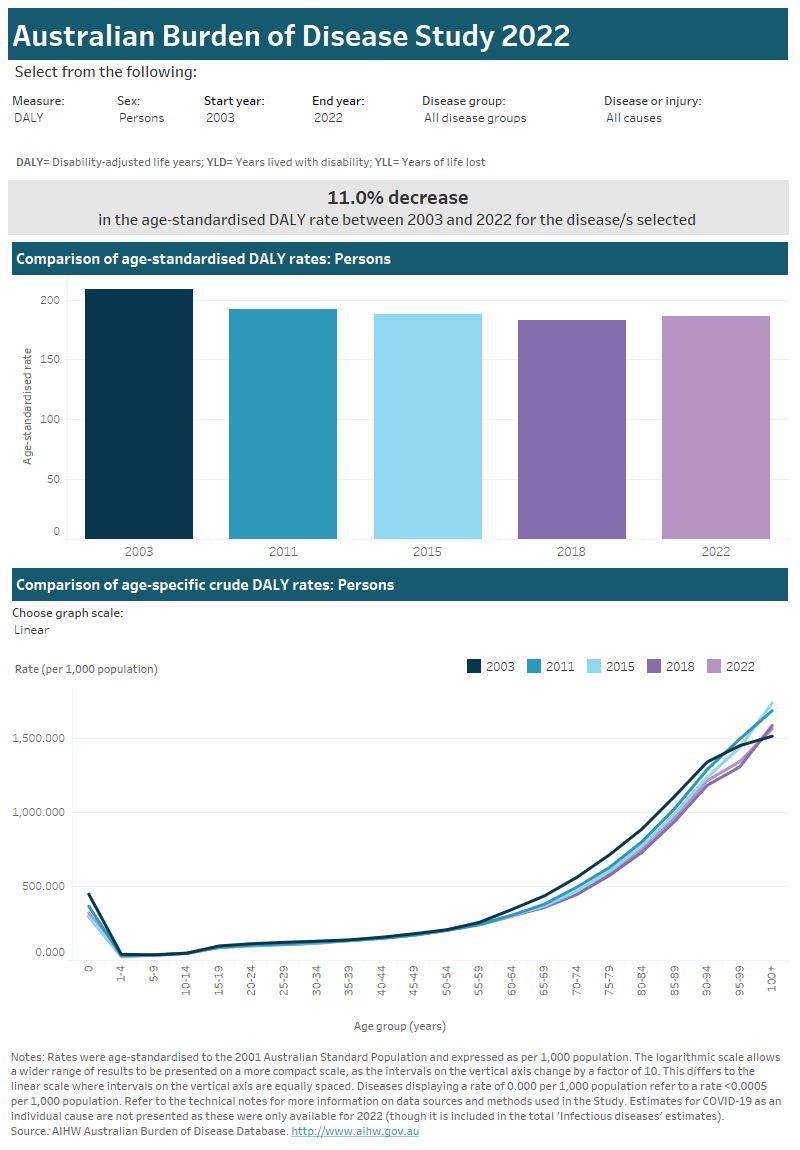Comparisons over time
Changes in burden over time from specific diseases or injuries may be due to changes in population size, population ageing, changes in disease prevalence (including epidemics) or changes to how causes are reported or coded in health data.
For fatal burden (YLL) estimates, notable changes in cause of death coding practices occurred over time for dementia and accidental poisoning. For non-fatal burden (YLD) estimates, morbidity data were drawn from a wide variety of sources, with varying availability and data quality over time. Of note, changes in testing practices and diagnostic criteria occurred over time for gestational diabetes. Therefore, comparisons over time for some causes need to be interpreted with caution. For example, for substance use and accidental poisoning, the 2022 projected estimates of fatal burden (YLL) were based on trend analysis starting from 2013, while dementia estimates were based on trend analysis from 2011 and gestational diabetes from 2015. See Box 1 in the Technical notes for more detail about the specific causes affected by changes to testing, diagnostic and coding practices, and the impact of these changes on burden of disease estimates.
Use the interactive graphs to explore differences in age-standardised and age-specific rates of burden (DALY, YLD or YLL) in Australia. Estimates are displayed by sex and for disease groups or by specific disease or injury for the most recent year (2022) and for years 2003, 2011, 2015 and 2018 for comparison.
As estimates for COVID-19 are only for the year 2022, comparisons of disease burden due to COVID-19 over time as an individual cause are not included in this visualisation. See the Disease/injury-specific summary visualisation for burden of disease estimates for COVID-19 in 2022. For a discussion of results related to comparisons over time, refer to the Summary.
Use the drop-down lists at the top of the visualisation to filter the data by measure of burden, sex, start and end year, disease group and disease/injury.

Hover over the bars or lines on the charts for additional information.
The toolbar at the bottom of the visualisation enables users to interact with the data in different ways:

Undo = Undo the latest filter applied.
Redo = Redo the latest filter applied.
Revert = Clears all filters applied and reverts visualisation to defaults filters.
Refresh = Connects to the underlying data source and updates the visualisation with any changes in the data (not applicable to this visualisation).
Pause = Stops the visualisation from updating each time a filter is changed, enabling multiple filters to be changed at once. Clicking ‘Resume’ will update the visualisation according to the selected filters.
Share = Generates a link that can be shared (note that filters will not be applied when link is shared).
Download = Allows a downloadable file as either an image (PNG), PDF or PowerPoint file. This is a useful way to save a snapshot of the visualisation to include in a document or presentation.
Full screen = Displays the dashboard in full screen mode (press Esc to return to original view).
This interactive data visualisation compares burden of disease in Australia over time for the years 2003, 2011, 2015, 2018 and 2022. There are 3 sections which can be customised to report data according to type of burden, start year, end year, sex, disease group and disease. The first section is a sentence which reports the percent change (increase or decrease) in the age-standardised rate of burden between the start and end year selected. The second section is a bar chart which compares the age-standardised rate of burden for each year. The third section is a line graph which compares age-specific rates of burden for each year.



